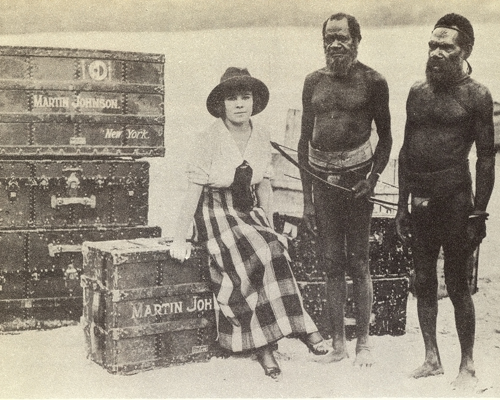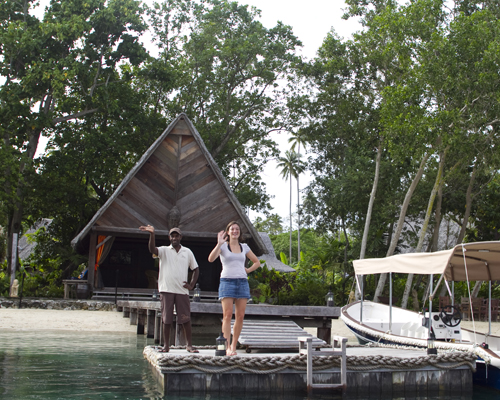“In pursuit of cannibals,” writes Pascal James Imperato in They Married Adventure: The Wandering Lives of Martin & Osa Johnson, “Martin and Osa sailed on the Pacifique for Vila, the capital of the New Hebrides (now Vanuatu), shortly after arriving in Sydney. They spent a few days in Noumea on New Caledonia before reaching Vila on October 26. At the suggestion of local traders and planters, they went on to Vao via Espiritu Santo. Here, Martin and Osa were given a warm reception by Father Prin and the local traders. The traditional culture was fairly intact at the time of their visit, and Martin was able to document much of it. Despite the influence of missionaries and traders, local customs remained strong, including the unappealing one of burying alive those close to death.”
And this is how Osa Johnson describes her first view of New Hebrides (now called Vanuatu) in her autobiography I Married Adventure: “After the glare of the beach I seemed suddenly blind, and slid and stumbled along a dark trail that was treacherous with hidden muddy streams and wet creepers. The heavy, steaming breath of the swamps pressed down on us with the weight of something dead, and in it was the ominous smell of rot and slime. Then we started to climb. Suddenly we were in the hot glare of the sun once more, and the slope was sharp and covered with brush and tough cane. We climbed for what seemed hours. A pulse beat hard in the roof of my mouth, my breath was like a knife in my chest and perspiration dripped from my hands.
“Just then there was a shuffling sound and we turned. A score of natives carrying guns had moved in behind us. I saw Martin’s face tighten.
“Then all heads turned, and there on the edge of the bush stood a figure so frightful as to be magnificent. His face, like those of the rest of the savages, was framed in a mass of black hair and beard. A bone was thrust through the cartilage of his nose. He wore the large pandanus fiber clout, but there was a difference in his bearing—the difference of a man of conscious power. There was power in his height, in the muscles that rippled under his glossy black skin, in his great shoulders, in the line of his jaw. Two furrows, amazingly deep, lay between his brows, and his eyes showed intelligence, strong will and cunning. Here was a chief by every right of physical and mental superiority. Here, I knew, was Nihapat.”
After traveling 40 hours on three flights to Espiritu Santo, the largest of the 83 islands, spread between the equator and the tropic of Capricorn, that make up Vanuatu (formerly New Hebrides), I was now on a small boat slowly making its way up the Segond Channel in the Coral Sea headed for the tiny island of Ratua. Thick tropical rain, wrung from gray sponge clouds low over the water, stopped and started every few minutes. Along the shore there was little to see; small huts, some built on stilts; a stark white cross above a stone church hidden in the thick green growth of the jungle; swaying heads of coconut trees, lined up like soldiers, in abandoned copra plantations.
No one on the boat spoke. Our guide, Frederick, stared intently at the GPS device at his side, while a deck hand, Abraham, leaned over the gunwales looking for uncharted reefs, flotsam from the rain, or slow-moving turtles drifting just below the surface. In my mind, I imagined Martin and Osa Johnson plying these same waters in 1917 when Osa described visiting a “little mud and grass church, with its quiet images and dim altar, so strange and beautiful on this savage island” and how in the early evening “the boo-boos (native drums) began to sound back in the bush….” As our little boat began to slow and head for land, I, too, heard sounds coming from the bush and, in the twilight, saw two figures standing at the end of a short pier, staring hard at us as we approached.
Then suddenly we were at the dock and hands were reaching down into the boat, grabbing at our luggage or lifting us up on to shore. We were escorted to an A-frame hut made of teak with a palm thatched roof where a young couple was sitting on cowhide chairs sipping martinis by candlelight. Softly, in the background, brushed drumming came from a jazz tune playing on an iPod. A young woman with extraordinary white teeth came up and offered me a glass of champagne. I looked at the chilled goblet as if it were the elixir of life itself. It had an aroma of warm toasty herbs and lemons.
“Welcome to Ratua,” said the woman. “Would you like another glass?”
We had arrived at our destination—Ratua—and, I noted, it appeared that local customs remained strong, including the rather appealing one of offering a cold glass of bubbly to those close to death. The adventure was on.
-
Hi Fred. Naw, this is way up north, although interestingly enough, I was hoping to go up to the volcano on Tanna but they’re telling me that it’s also erupting at the moment and they don’t know if I’d be allowed up there. I guess the earth is erupting all over the place!
Comments are now closed.



4 comments